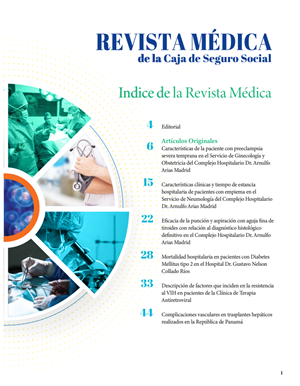DESCRIPTION OF FACTORS THAT INCIDENT IN HIV RESISTANCE IN PATIENTS OF THE COLON ANTIRETROVIRAL THERAPY CLINIC. 2016-2017
Main Article Content
Abstract
Access to antiretroviral treatment is one of the most important tools for the control of HIV transmission, as well as to achieve a quality life in people living with this virus, however, the resistance to treatment and the consequent virological failure they are the main fear we have today, it has a relationship not only with the high replicative capacity of the virus, but also due to inadequate viral exposure to antiretroviral drugs, which promotes the appearance of mutated and resistant viral strains.
We conducted a non-experimental, cross-sectional and retrospective review of files, managing to evaluate 37 clinical and epidemiological characteristics that could represent risk factors for TARV resistance. We were able to study a total of 48 patients with resistance to antiretrovirals treated at the Clinic of TARV of Colon in the years 2016-2017
Data were recorded from 48 patients, 52% women and 48% men, 60% being between 30-50 years of age, and 50% being black. 40% had between 6-10 years of diagnosis and 69% started TARV in the first 24 months of diagnosis. 44% presented resistance in the first 5 years of receiving TARV. Only 13% presented a university education. 66% had heterosexual relationships.
We found that in addition to poor adherence, factors such as the onset of TARV, diagnosed years, viral load levels and CD4 +, opportunistic diseases, having been an AIDS stage, may represent a risk factor for the appearance of resistance to antiretroviral drugs.
Downloads
Article Details
Issue
Section

This work is licensed under a Creative Commons Attribution-NonCommercial 4.0 International License.
How to Cite
References
1. Normas para el Manejo Terapéutico de las Personas con VIH en la República de Panamá. Ministerio de Salud, Caja del Seguro Social 2011.
2. Resistencia al TARGA, Falla terapéutica y Adherencia. Dr. Víctor Mulanovich, Dr. Raúl Gutiérrez. Instituto de Medicina Tropical Alexander Von Humboldt, Universidad Peruana Cayetano Heredia
3. Impact of transmitted drug resistance on art failure in Uganda. October 2014. Author: Mark Mascolini. International Aids Society.
4. Resistance to Antiretroviral Treatment in Gabon: Need for Implementation of Guideline son Antiretroviral Therapy Use and HIV-1 Drug Resistance Monitoring in Developing Countries. Laurence Vergne, Gabriel Malonga-Mouellet. University of Montpellier I, Montpellier, France; National Aids Program, Libreville; and † Central Hospital, USROC, Libreville, Gabon
5. Plan Estratégico Nacional Multisectorial de ITS VIH y Sida 2009-2014
6. Cuándo empezar el tratamiento antirretroviral. Info SIDA, febrero 2018
7. Guidelines for the Use of Antiretroviral Agents in HIV-1-Infected Adults and Adolescents. AidsInfo 2016
8. Tratamiento antirretroviral bajo la lupa: un análisis de salud pública en Latinoamérica y el Caribe. Organización Panamericana de Salud. 2012
9. Resistencia al VIH por genotipificación y características asociadas en pacientes sin exposición previa al tratamiento antirretroviral (NAIVES) bajo atención integral especializada de la corporación de Lucha contra el SIDA entre el periodo de enero del 2008 y diciembre 2010. Dr. Pablo Galindo, Universidad de La Sabana, Bogotá 2012.
10. Tasa de mutaciones genotípicas y resistencia a antirretrovirales en un hospital general. L.C. Fernández Lisón, L.M. Fernández Pereira, S. Romero Chala. Hospital de Cáceres España, noviembre 2010.
11. Mapa de Resistencia Humana al Virus del VIH. Jacques Fellay, Escuela Politecnica de Lausana (EPFL) y del Hospital Universitario del cantón de Vaud, Suiza 2013.
12. Determinación de los factores que favorecen la adherencia terapéutica de pacientes con VIH atendidos en la consulta del servicio de Infectología de la Ciudad Hospitalaria Enrique Tejera año 2011. Maryangélica Ortuño M., Nellwys M. Oropeza, Elias
J. Aparicio R., Francis M. Orozco A. Departamento Clínico Integral del Sur. Escuela de Medicina. Facultad Ciencias de la Salud. Universidad de Carabobo, Venezuela 2012.
13. Incidence and risk factors for first line anti retroviral treatment failure among Ugandan children attending an urban HIV clinic. Robert Sebunya, Victor Musiime, Sabrina Bakeera Kitaka and Grace Ndeezi. 2013.
14. Informe Mundial ONUSIDA. Epidemia Mundial 2013.
15. Prevención del VIH a través de pruebas, tratamiento y atención médica. CDC (Centro para el Control y la Prevención de Enfermedades).
16. HIV Treatment GLOBAL UPDATE ON HIV
TREATMENT 2013: Results, Impact and Opportunities. WHO report in partnershipwith UNICEF AND UNAIDS. June 2013.
17. Guía para el Uso de MEDICAMENTOS ANTIRRETROVIRALES 5ta. edición, 2011. Acción Ciudadana Contra el SIDA, Venezuela.
18. Resistencia Primaria de HIV-1: estado de situación en Argentina. 2010 Alejandro Petroni.
19. Response to antiretroviral treatment in HIV-1- infected individuals with allelic variants of the multidrug resistance transporter 1: A pharmacogenetics study.Jacques Fellay MD, Catia MarzoliniPhrmaD.
20. Dolutegravir-Rilpivirine Effective for Maintaining HIV Suppression. WillBoggs MD. January 22, 2018.

